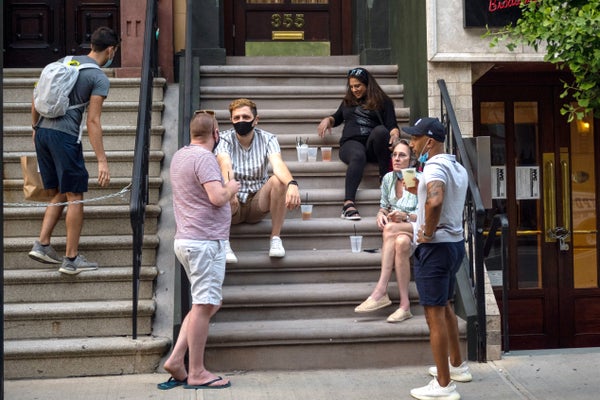Editor’s Note (5/13/21): After this story was published, the Centers for Disease Control and Prevention released new guidelines stating that fully vaccinated people do not need to wear masks in most indoor settings, apart from certain places, such as hospitals, nursing homes, jails and public transportation. The agency also updated earlier guidance on outdoor masking, saying vaccinated individuals do not need to wear masks when they are outside, regardless of crowd size. The latest recommendations could incentivize more Americans to get vaccinated, but they are likely to stir debate about whether the move is premature. Immunocompromised people should consult their doctors before going maskless, said CDC director Rochelle Walensky in a White House briefing announcing the new guidance. Many vaccinated people may opt to keep their mask on, and they should not be criticized, said Anthony Fauci, the president’s chief medical adviser, at the press briefing.
Citing the extremely low risk of outdoor COVID-19 transmission, the U.S. Centers for Disease Control and Prevention has announced that fully vaccinated people do not need to wear masks when they are outside in small groups of friends or family. The CDC still recommends outdoor masking for unvaccinated (or partially vaccinated) individuals—and for fully vaccinated people at large outdoor gatherings such as sports events or concerts—until widespread vaccination is achieved. The new guidance acknowledges something many experts on airborne virus transmission have been saying for months: the risk of getting COVID is a lot lower outdoors than indoors. Vaccination reduces that risk even more.
“The examples today show that when you are fully vaccinated, you can return to many activities safely—and most of them outdoors and unmasked—and begin to get back to normal,” said CDC director Rochelle Walensky in a press briefing on the new guidance on Tuesday.
On supporting science journalism
If you're enjoying this article, consider supporting our award-winning journalism by subscribing. By purchasing a subscription you are helping to ensure the future of impactful stories about the discoveries and ideas shaping our world today.
Experts have greeted the announcement positively. “Changes in guidelines for outdoor masking are welcome because we know that transmission outdoors is much less likely than indoors,” said Linsey Marr, a Virginia Tech engineering professor with expertise in aerosols, in a statement. “The virus spreads most commonly by breathing it in from the air, usually coming from people nearby, or sometimes farther away if you are in a poorly ventilated room. Outdoors, the virus cannot accumulate in the air. It quickly becomes diluted in the atmosphere like a drop of dye in the ocean.”
Marr noted the guidance is somewhat confusing, however. It says that if you are vaccinated, you do not need to wear a mask to take part in small outside gatherings with friends who are unvaccinated—yet it also suggests that unvaccinated people should wear a mask in gatherings of both vaccinated and unvaccinated people. In addition, the CDC says vaccinated people can dine at an outdoor restaurant with friends from other households, but Marr added that if those friends are unvaccinated, they should not be dining together.
Early in the pandemic, many health authorities believed the virus spread primarily through contact with surfaces (technically called fomites) or through relatively large droplets that fall to the ground rather than through aerosols—extremely tiny droplets that remain suspended in the air. But there is now a wealth of evidence that the virus spreads at least partially (and maybe even primarily) through the air. A recent preprint study, funded by the World Health Organization, suggested a lack of firm conclusions about airborne transmission of SARS-CoV-2, the virus that causes COVID-19. In response, a group of scientists and researchers published a paper in the Lancet laying out 10 factors supporting the idea of primarily airborne spread. Among them was the much greater risk of transmission indoors versus outdoors.
With the new CDC guidance, vaccinated people can breathe a maskless sigh of relief that they can return to some semblance of normalcy. But the pandemic is not over yet.
According to Marr, outdoor masking among vaccinated people is still important in certain situations, such as standing in a big line or attending a sporting event. She added that she would recommend masking in any outdoor face-to-face conversations longer than a quick “How are you?”
To keep track of when you should wear a mask, Marr recommended following a “two-out-of-three rule”: being outside, masking and distancing. So if you are outdoors, you should either keep some distance from other people or wear a mask. This applies to both unvaccinated and partially vaccinated individuals and to anyone who is fully vaccinated but in a vulnerable group. “Those who are fully vaccinated and healthy have a little more leeway,” Marr said. But she still recommended wearing a mask around crowds and strangers. It would be great if we could just “flip a switch” and return to normal, but doing so too quickly only risks more COVID cases and deaths, Marr said. “We will have to tolerate a period of gradual lifting of precautions as we navigate toward a new normal.”
Read more about the coronavirus outbreak from Scientific Americanhere. And read coverage from our international network of magazines here.
